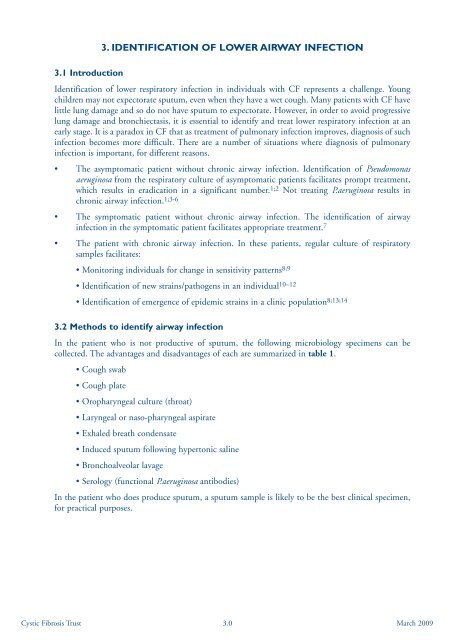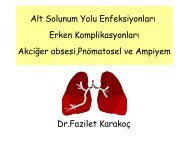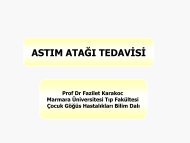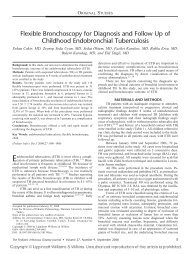39. Regelmann WE, Elliott GR, Warwick WJ, Clawson CC. Reduction <strong>of</strong> sputum Pseudomonas aeruginosa density byantibiotics improves lung function in cystic fibrosis more than do bronchodilators and chest physio<strong>the</strong>rapy alone.Am Rev Respir Dis 1990;141:914–21.40. Wolter JM, Bowler SD, McCormack JG. Are antipseudomonal antibiotics really beneficial in acute respiratoryexacerbations <strong>of</strong> cystic fibrosis? Aust N Z J Med 1999;29:15–21.41. Smith AL, Fiel SB, Mayer-Hamblett N, Ramsey B, Burns JL. Susceptibility testing <strong>of</strong> Pseudomonas aeruginosaisolates and clinical response to parenteral antibiotic administration: lack <strong>of</strong> association in cystic fibrosis. Chest2003;123:1495–502.42. Sanchez P, Linares JF, Ruiz-Diez B, Campanario E, Navas A, Baquero F et al. Fitness <strong>of</strong> in vitro selectedPseudomonas aeruginosa nalB and nfxB multidrug resistant mutants. J Antimicrob Chemo<strong>the</strong>r 2002;50:657–64.43. Fonseca AP, Extremina C, Fonseca AF, Sousa JC. Effect <strong>of</strong> subinhibitory concentration <strong>of</strong> piperacillin/tazobactamon Pseudomonas aeruginosa. J Med Microbiol 2004;53:903-10.44. Wagner T, Soong G, Sokol S, Saiman L, Prince A. Effects <strong>of</strong> azithromycin on clinical isolates <strong>of</strong> Pseudomonasaeruginosa from cystic fibrosis patients. Chest 2005;128:912–9.45. Perry JD, Laine L, Hughes S, Nicholson A, Galloway A, Gould FK. Recovery <strong>of</strong> antimicrobial-resistantPseudomonas aeruginosa from sputa <strong>of</strong> cystic fibrosis patients by culture on selective media. J Antimicrob Chemo<strong>the</strong>r2008;61:1057–61.46. Kahlmeter G, Brown DF, Goldstein FW, MacGowan AP, Mouton JW, Osterlund A et al. European harmonization<strong>of</strong> MIC breakpoints for antimicrobial susceptibility testing <strong>of</strong> bacteria. J Antimicrob Chemo<strong>the</strong>r 2003;52:145–8.47. Moriarty TF, McElnay JC, Elborn JS, Tunney MM. Sputum antibiotic concentrations: implications for treatment<strong>of</strong> cystic fibrosis lung infection. Pediatr Pulmonol 2007;42:1008–17.48. Burns JL, Van Dalfsen JM, Shawar RM, Otto KL, Garber RL, Quan JM et al. Effect <strong>of</strong> chronic intermittentadministration <strong>of</strong> inhaled tobramycin on respiratory microbial flora in patients with cystic fibrosis. J Infect Dis1999;179:1190–6.49. Aaron SD. <strong>Antibiotic</strong> synergy testing should not be routine for patients with cystic fibrosis who are infected withmultiresistant bacterial organisms. Paediatr Respir Rev 2007;8:256–61.<strong>Cystic</strong> <strong>Fibrosis</strong> <strong>Trust</strong> 2.9March 2009
3.1 Introduction3. IDENTIFICATION OF LOWER AIRWAY INFECTIONIdentification <strong>of</strong> lower respiratory infection in individuals with CF represents a challenge. Youngchildren may not expectorate sputum, even when <strong>the</strong>y have a wet cough. Many patients with CF havelittle lung damage and so do not have sputum to expectorate. However, in order to avoid progressivelung damage and bronchiectasis, it is essential to identify and treat lower respiratory infection at anearly stage. It is a paradox in CF that as treatment <strong>of</strong> pulmonary infection improves, diagnosis <strong>of</strong> suchinfection becomes more difficult. There are a number <strong>of</strong> situations where diagnosis <strong>of</strong> pulmonaryinfection is important, for different reasons.• The asymptomatic patient without chronic airway infection. Identification <strong>of</strong> Pseudomonasaeruginosa from <strong>the</strong> respiratory culture <strong>of</strong> asymptomatic patients facilitates prompt treatment,which results in eradication in a significant number. 1;2 Not treating P.aeruginosa results inchronic airway infection. 1;3-6• The symptomatic patient without chronic airway infection. The identification <strong>of</strong> airwayinfection in <strong>the</strong> symptomatic patient facilitates appropriate treatment. 7• The patient with chronic airway infection. In <strong>the</strong>se patients, regular culture <strong>of</strong> respiratorysamples facilitates:• Monitoring individuals for change in sensitivity patterns 8;9• Identification <strong>of</strong> new strains/pathogens in an individual 10–12• Identification <strong>of</strong> emergence <strong>of</strong> epidemic strains in a clinic population 8;13;143.2 Methods to identify airway infectionIn <strong>the</strong> patient who is not productive <strong>of</strong> sputum, <strong>the</strong> following microbiology specimens can becollected. The advantages and disadvantages <strong>of</strong> each are summarized in table 1.• Cough swab• Cough plate• Oropharyngeal culture (throat)• Laryngeal or naso-pharyngeal aspirate• Exhaled breath condensate• Induced sputum following hypertonic saline• Bronchoalveolar lavage• Serology (functional P.aeruginosa antibodies)In <strong>the</strong> patient who does produce sputum, a sputum sample is likely to be <strong>the</strong> best clinical specimen,for practical purposes.<strong>Cystic</strong> <strong>Fibrosis</strong> <strong>Trust</strong> 3.0March 2009
- Page 3 and 4: 4. ORAL ANTIBIOTICS IN CYSTIC FIBRO
- Page 5 and 6: 7. OTHER INFECTIONS7.1 Management o
- Page 7 and 8: GRADING SCHEME FOR LEVELS OF EVIDEN
- Page 9 and 10: SUMMARY•All young children with c
- Page 11: In 1989 the Copenhagen centre recom
- Page 15 and 16: These bacteria can be harmless comm
- Page 17 and 18: 2.7 Clinical relevance of in vitro
- Page 19: 17. Macia MD, Blanquer D, Togores B
- Page 23 and 24: Table 2: Laboratory techniques and
- Page 25 and 26: 20. Hoppe JE, Theurer MU, Stern M.
- Page 27 and 28: 4.2.4 Recommendations for treatment
- Page 29 and 30: 4.5 Use of oral antibiotics at time
- Page 31 and 32: groups in terms of the chronic use
- Page 33 and 34: 5.1 Introduction5. NEBULISED ANTIBI
- Page 36 and 37: 5.5 Nebulised antibiotics to preven
- Page 38 and 39: 5.10.2 Recommendations for administ
- Page 40 and 41: • If a facemask is used the face
- Page 42 and 43: 5.16 Nebuliser/compressor systems f
- Page 44 and 45: 19. Ratjen F, Walter H, Haug M, Mei
- Page 46 and 47: 69. Pitchford KC, Corey M, Highsmit
- Page 48 and 49: outcome between active and placebo
- Page 50 and 51: Drug Route Age/weight DoseFrequency
- Page 52 and 53: much sooner. A minimum of 10-14 day
- Page 54 and 55: 6.8 References1. Armstrong DS, Grim
- Page 56 and 57: 7. OTHER INFECTIONS7.1 Management o
- Page 58 and 59: 7.2 Respiratory infection with meti
- Page 60 and 61: Table 7.2 Published data on eradica
- Page 62 and 63: 7.4.2 Recommendations• Given the
- Page 64 and 65: although not all authors have found
- Page 66 and 67: Table 7.3 Drugs for treatment of My
- Page 68 and 69: 7.9.2 Diagnosis of ABPAThe Cystic F
- Page 70 and 71:
• It is important to assess the c
- Page 72 and 73:
12. Blackburn L, Brownlee K, Conway
- Page 74 and 75:
57. Ballestero S, Virseda I, Escoba
- Page 76 and 77:
107. Deerojanawong J, Sawyer SM, Fi
- Page 78 and 79:
155. Stevens DA, Moss RB, Kurup VP,
- Page 80 and 81:
8. PHARMACOPOEIAOriginally based on
- Page 82 and 83:
8.3 Treatment of more severe exacer
- Page 84 and 85:
Co-amoxiclav orallyAge Dose Frequen
- Page 86 and 87:
Cefotaxime intravenouslyAge Dose Fr
- Page 88 and 89:
8.7 Treatment of Pseudomonas aerugi
- Page 90 and 91:
8.8.3 Other ß-lactam antibioticsTh
- Page 92 and 93:
Amikacin intravenouslyAge Dose Freq
- Page 94 and 95:
8.10 Chronic oral anti-pseudomonal
- Page 96 and 97:
TemocillinAge Dose Frequency>12year
- Page 98 and 99:
Liposomal Amphotericin (“Ambisome
- Page 100 and 101:
9. ANTIBIOTIC-RELATED ALLERGIES AND
- Page 102:
I N F O R M A T I O NCystic Fibrosi






